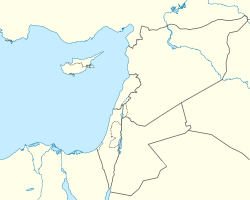Samuel Lyde
Samuel Lyde (1825–1860) was an
Life and missionary work
Lyde was born in 1825.
Lyde was persuaded by the idea. From 1853 to 1859, he lived among the Alawite community of the

Lyde travelled to
Lyde developed a deranged mental state and had delusions that he was
Publications and influence

Lyde wrote two books on the Alawites: The Anseyreeh and Ismaeleeh: A Visit to the Secret Sects of Northern Syria with a View to the Establishment of Schools (1853) and The Asian Mystery Illustrated in the History, Religion and Present State of the Ansaireeh or Nusairis of Syria (1860).[14] The latter is considered to be a pioneering work, and was the first monograph to be written on the Alawite-Nusayri religion.[15][16] It remained the only Western book on the subject until 1900, when René Dussaud published his Histoire et religion des Nosairîs.[16]
His description of Alawite doctrines was based on a document called Kitab al-mashyakha ("The Manual of the Shaykhs"),[17] which he said he had bought from a Christian merchant from Latakia.[16] This document appears to have differed in certain respects from other sources on Alawite doctrine.[17] For many years it was thought to have been lost and only available through the extracts quoted in translation by Lyde.[17] In 2013, it was announced that the document Lyde had used had been discovered in the archives of the Old Library of Jesus College, Cambridge.[18] Lyde had bequeathed it to his old college, and, apparently, had sent it to Cambridge shortly before his death.[18]
His writing reveals a negative view of the Alawites and, in particular, he was critical of what he saw as their brigandage, feuds, lying and divorce.[4] He went as far as saying that "the state of [Alawi] society was a perfect hell upon earth".[19] The Asian Mystery became a popular book and has been described as "colourful" but "unreliable" in some respects.[4] Nevertheless, Lyde's account remains an influential source on Alawites, and, for instance, is widely quoted on the internet.[4]
Notes
References
- ^ ISBN 978-3-8258-8920-3.
- S2CID 163066384.
- ^ a b c Lyde, Samuel (1853). The Anseyreeh and Ismaeleeh: A Visit to the Secret Sects of Northern Syria with a View to the Establishment of Schools. pp. i, iii–iv.
- ^ a b c d e f "Secretive sect of the rulers of Syria". The Telegraph. 5 August 2011. Retrieved 4 January 2013.
- ISBN 978-0-8156-2411-0.
- ISBN 978-88-218-0437-3. Retrieved 9 January 2013.
- ^ Joffe, Lawrence (18 October 2005). "Major-General Ghazi Kanaan". The Guardian. Retrieved 7 July 2012.
- ^ OCLC 742343.
- ^ ISBN 978-0-14-101350-3.
- ^ ISBN 978-1-56663-189-1.
- ^ Lyde, Samuel (1860). The Asian Mystery Illustrated in the History, Religion and Present State of the Ansaireeh or Nusairis of Syria. p. viii.
- ISBN 978-1-60178-019-5.
- S2CID 163066384.
- ISBN 978-0-7914-3119-1.
- ^ Bar-Asher, M. M. (2003). "The Iranian Component of the Nusayri Religion". Iran: Journal of the British Institute of Persian Studies. 41: 223.
- ^ ISBN 978-0-520-06976-3.
- ^ ISBN 978-90-04-17892-2.
- ^ S2CID 163066384.
- ISBN 978-0-19-506022-5.
External links
Full texts of Lyde's works via

